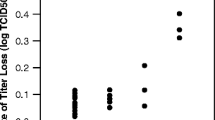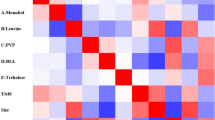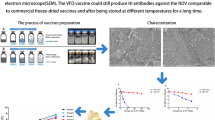Abstract
Objectives
To investigate the impact of drying method on the storage stability of dried vaccine formulations.
Materials and Methods
A sucrose-based formulation of a live attenuated virus vaccine of a parainfluenza strain, with and without surfactant, was dried from by different methods; freeze drying, spray drying and foam drying. Dried powders were characterized by differential scanning calorimetry, specific surface area (SSA) analysis and by electron spectroscopy for chemical analysis (ESCA) to evaluate vaccine surface coverage in the dried formulations. Dried formulations were subjected to storage stability studies at 4, 25 and 37°C. The vaccine was assayed initially and at different time points to measure virus-cell infectivity, and the degradation rate constant of the vaccine in different dried preparations was determined.
Results
SSA was highest with the spray dried preparation without surfactant (∼ 2.8 m2/g) and lowest in the foam dried preparations (with or without surfactant) (∼ 0.1 m2/g). Vaccine surface coverage was estimated based on ESCA measurements of nitrogen content. It was predicted to be highest in the spray dried preparation without surfactant and lowest in the foam with surfactant. Stability studies conducted at 25°C and 37°C showed that the vaccine was most stable in the foam dried preparation with surfactant and least stable in spray dried preparations without surfactant and in all freeze dried preparations regardless of the presence of surfactant. Addition of surfactant did lower the SSA and vaccine surface coverage in freeze dried preparations but still did not improve storage stability.
Conclusions
In drying methods that did not involve a freezing step, good storage stability of Medi 534 vaccine in the dried form was found with low SSA and low vaccine surface accumulation, both of which integrate into low fraction of vaccine at the surface. Ice appears to be a major destabilizing influence.








Similar content being viewed by others
References
D. T. O’Hagan and R. Rappuoli. Novel approaches to vaccine delivery. Pharm. Res. 21:1519–1530 (2004).
D. O. White and F. J. Fenner. Medical Virology, 3rd ed. Academic, Orlando, FL, 1987.
D. J. A. Crommelin and R. D. Sindelar. Pharmaceutical Biotechnology: An Introduction for Pharmacists and Pharmaceutical Scientists, 2nd ed. Taylor & Francis, New York, 2002.
D. T. Brandau, L. S. Jones, and C. R. Middaugh. Thermal stability of vaccines. J. Pharm. Sci. 92:218–231 (2003).
R. Bey, R. Simonson, and N. Garcon. Formulation of vaccines. Drugs Pharm. Sci. 88:283–303 (1998).
D. Greiff. Comparative studies of the cryobiology of viruses classified according to their physicochemical characteristics. Freezing drying microorganisms, Pap. Conf. \"Mech. Cell. Inj. Freezing Drying Microorganisms\" 69–80 (1969).
J. Rexroad, R. K. Evans, and C. R. Middaugh. Effect of pH and lonic strength on the physical stability of adenovirus type 5. J. Pharm. Sci. 95:237–247 (2005).
Y.-F. Maa, M. Ameri, and D. Chen. Influenza vaccine powder formulation development: spray-freeze-drying and stability evaluation. J. Pharm. Sci. 93:1912–1923 (2004).
Y.-F. Maa, M. Ameri, and D. Chen. Spray-coating for biopharmaceutical powder formulations: beyond the conventional scale and its application. Pharm. Res. 21:515–523 (2004).
D. I. Annear. The preservation of bacteria by drying in peptone plugs. J. Hyg. 54:487–508 (1956).
D. I. Annear. Recoveries of bacteria after drying in vacuo at a bath temperature of 100 degrees C. Nature 211:761 (1966).
D. I. Annear. Recoveries of bacteria after drying and heating in glutamate foams. J. Hyg. 68:457–459 (1970).
E. E. Worrall, J. K. Litamoi, and G. Ayelet. Xerovac: an ultra rapid method for the dehydration and preservation of live attenuated Rinderpest and Peste des Petits ruminants vaccines. Vaccine 19:834–839 (2000).
V. Truong-Le. Preservation of bioactive materials by freeze dried foam, (Medimmune Vaccines, Inc., USA). Application: WO, 2003, pp. 72 pp.
M. Mattern, G. Winter, and G. Lee. Formulation of proteins in vacuum-dried glasses. Part 1. Improved vacuum-drying of sugars using crystallizing amino acids. Eur. J. Pharm. Biopharm. 44:177–185 (1997).
M. Mattern, G. Winter, and G. Lee. Formulation of proteins in vacuum-dried glasses. II. Process and storage stability in sugar-free amino acid systems. Pharm. Dev. Technol. 4:199–208 (1999).
D. Greiff, W. A. Rightsel, and E. E. Schuler. Effects of freezing, storage at low temperatures, and drying by sublimation in vacuo on the activities of measles virus. Nature 202:624–625 (1964).
W. A. Rightsel and D. Greiff. Freezing and freeze-drying of viruses. Cryobiology 3:423–431 (1967).
V. Truong-Le and T. Scherer. High pressure spray-dry of bioactive materials, (Medimmune Vaccines, Inc., USA). Application: WO, 2005, pp. 71 pp.
B. A. Szkudlarek, T. J. Anchordoquy, and N. Rodriguez-Hornedo. pH changes of phosphate buffer solutions during freezing and their influence on the stability of a model protein, lactate dehydrogenase. In Book of Abstracts, 211th ACS National Meeting, New Orleans, LA, March 24–28 BIOT-138 (1996).
G. Lee. Spray-drying of proteins. Pharm. Biotechnol. 13:135–158 (2002).
N. Jovanovic, A. Bouchard, and W. Jiskoot. Stabilization of proteins in dry powder formulations using supercritical fluid technology. Pharm. Res. 21:1955–1969 (2004).
S. D. Webb, S. L. Golledge, and T. W. Randolph. Surface adsorption of recombinant human interferon-g in lyophilized and spray-lyophilized formulations. J. Pharm. Sci. 91:1474–1487 (2002).
C. Bosquillon, P. G. Rouxhet, and R. Vanbever. Aerosolization properties, surface composition and physical state of spray-dried protein powders. J. Control. Release 99:357–367 (2004).
A. Millqvist-Fureby, M. Malmsten, and B. Bergenstahl. Surface characterization and activity preservation in spray-drying of trypsin. Int. J. Pharm. 188:243–253 (1999).
D. Greiff. Stabilities of suspensions of influenza virus dried by sublimation of ice in vacuo to different contents of residual moisture and sealed under different gases. Appl. Microbiol. 20:935–938 (1970).
H. R. Costantino, S. P. Schwendeman, and R. Langer. The secondary structure and aggregation of lyophilized tetanus toxoid. J. Pharm. Sci. 85:1290–1293 (1996).
S. Prestrelski, N. Tedeschi, T. Arakawa, and J. F. Carpenter. Dehydration-induced conformational transitions in proteins and their inhibition by stabilizers. Biophys. J. 65:661–671 (1993).
S. J. Prestrelski, K. A. Pikal, and T. Arakawa. Optimization of lyophilization conditions for recombinant human interleukin-2 by dried-state conformational analysis using Fourier-transform infrared spectroscopy. Pharm. Res. 12:1250–1259 (1995).
A. Millqvist-Fureby, M. Malmsten, and B. Bergenstahl. Surface characterization of freeze-dried protein/carbohydrate mixtures. Int. J. Pharm. 191:103–114 (1999).
M. Adler and G. Lee. Stability and surface activity of lactate dehydrogenase in spray-dried trehalose. J. Pharm. Sci. 88:199–208 (1999).
P. Faeldt and B. Bergenstahl. The surface composition of spray-dried protein-lactose powders. Colloids Surf., A Physicochem. Eng. Asp. 90:183–90 (1994).
M. Suzuki. Protectants in the freeze-drying and the preservation of Vaccinia virus. Cryobiology 10:435–439 (1973).
A. Abdul-Fattah, M. Pikal, and D. Lechuga-Ballesteros. Composition heterogeneity effects due to variation in processing and formulation of Methionyl-human Growth Hormone. In AAPS National Biotechnology Conference, San Francisco, CA, 2005.
A. Abdul-Fattah, D. Kalonia, M. Pikal, and D. Lechuga-Ballesteros. The surface composition of spray dried and freeze dried protein formulations with varying molecular weight stabilizers. In American Association of Pharmaceutical Scientists Annual Meeting, Nashville, TN, 2005.
A. Abdul-Fattah, D. Kalonia, and M. Pikal. The challenge of drying method selection for protein pharmaceuticals: product quality implications. Manuscript in preparation.
J. F. Carpenter, M. J. Pikal, and T. W. Randolph. Rational design of stable lyophilized protein formulations: some practical advice. Pharm. Res. 14:969–975 (1997).
J. F. Carpenter, M. C. Manning, and Editors. Rational design of stable protein formulations: theory and practice. [In: Pharm. Biotechnol., 2002; 13], 2002.
R. S. Tang, J. H. Schickli, and A. A. Haller. Effects of human metapneumovirus and respiratory syncytial virus antigen insertion in two 3′ proximal genome positions of bovine/human parainfluenza virus type 3 on virus replication and immunogenicity. J. Virol. 77:10819–10828 (2003).
A. A. Haller, T. Miller, and K. Coelingh. Expression of the surface glycoproteins of human parainfluenza virus type 3 by bovine parainfluenza virus type 3, a novel attenuated virus vaccine vector. J. Virol. 74:11626–11635 (2000).
S. D. Sovani, E. Chou, and J. D. Crofts. High pressure effervescent atomization: effect of ambient pressure on spray cone angle. Fuel 80:427–435 (2001).
L. I. Yin and I. Adler. Electron spectroscopy. Instrum. Anal. 418–442 (1978).
S. Zhai, R. Hansen, R. Taylor, J. Skepper, R. Sanches, and N. Slater. Effect of freezing rates and excipients on the infectivity of a live viral vaccine during lyophilization. Biotechnol. Prog. 20:1113–1120 (2004).
P. P. a. M. Trudel. Isolation and identification of viruses. In M. T. a. R. A. Pierre Payment (ed.), Methods and Techniques in Virology (M. T. a. R. A. Pierre Payment, ed), Marcel Dekker, Inc., New York, NY, 1993, pp. 30–35.
Q. Lu and G. Zografi. Phase behavior of binary and ternary amorphous mixtures containing indomethacin, citric acid, and PVP. Pharm. Res. 15:1202–1206 (1998).
K. Izutsu, S. Yoshioka, and J. F. Carpenter. Effects of sugars and polymers on crystallization of poly(ethylene glycol) in frozen solutions: phase separation between incompatible polymers. Pharm. Res. 13:1393–1400 (1996).
X. Lu and M. J. Pikal. Freeze-drying of Mannitol-Trehalose-Sodium Chloride-based formulations: the impact of annealing on dry layer resistance to mass transfer and cake structure. Pharm. Dev. Technol. 9:85–95 (2004).
M. J. Pikal, S. Shah, and J. E. Lang. Physical chemistry of freeze-drying: measurement of sublimation rates for frozen aqueous solutions by a microbalance technique. J. Pharm. Sci. 72:635–650 (1983).
J. A. Searles, J. F. Carpenter, and T. W. Randolph. Annealing to optimize the primary drying rate, reduce freezing-induced drying rate heterogeneity, and determine T(g)′ in pharmaceutical lyophilization. J. Pharm. Sci. 90:872–887 (2001).
P. Faeldt, B. Bergenstahl, and G. Carlsson. The surface coverage of fat on food powders analyzed by ESCA (electron spectroscopy for chemical analysis). Food Struct. 12:225–234 (1993).
M. Adler, M. Unger, and G. Lee. Surface composition of spray-dried particles of bovine serum albumin/trehalose/surfactant. Pharm. Res. 17:863–870 (2000).
M. J. Pikal and D. R. Rigsbee. The stability of insulin in crystalline and amorphous solids: observation of greater stability for the amorphous form. Pharm. Res. 14:1379–1387 (1997).
J. Liu, D. R. Rigsbee, and M. J. Pikal. Dynamics of pharmaceutical amorphous solids: the study of enthalpy relaxation by isothermal microcalorimetry. J. Pharm. Sci. 91:1853–1862 (2002).
S. Yoshioka, Y. Aso, and S. Kojima. Usefulness of the Kohlrausch-Williams-Watts stretched exponential function to describe protein aggregation in lyophilized formulations and the temperature dependence near the glass transition temperature. Pharm. Res. 18:256–260 (2001).
W. N. Fishbein and J. W. Winkert. Parameters of biological freezing damage in simple solutions: catalase. I. The characteristic pattern of intracellular freezing damage exhibited in a membraneless system. Cryobiology 14:389–398 (1977).
B. S. Bhatnagar, S. J. Nehm, and R. H. Bogner. Post-thaw aging affects activity of lactate dehydrogenase. J. Pharm. Sci. 94:1382–1388 (2005).
A. M. Abdul-Fattah, V. Truong-Le, L. Yee, L. Nguyen, D. Kalonia, M. T. Cicerone, and M. Pikal. Drying-induced variations in physico-chemical properties of amorphous pharmaceuticals and their impact on stability I: stability of a monoclonal antibody I. J. Pharm. Sci. (2007) in press.
X. Tang and M. J. Pikal. Measurement of the kinetics of protein unfolding in viscous systems and implications for protein stability in freeze-drying. Pharm. Res. 22:1176–1185 (2005).
S. U. Sane, R. Wong, and C. C. Hsu. Raman spectroscopic characterization of drying-induced structural changes in a therapeutic antibody: correlating structural changes with long-term stability. J. Pharm. Sci. 93:1005–1018 (2004).
F. Poirier-Brulez, G. Roudaut, and D. Simatos. Influence of sucrose and water content on molecular mobility in starch-based glasses as assessed through structure and secondary relaxation. Biopolymers 81:63–73 (2006).
Acknowledgements
We would like to acknowledge MedImmune Vaccines for financial support for this project. We would also like to acknowledge Dr. Daniel Goberman from the Surface Sciences Laboratory in the Institute for Materials Sciences at the University of Connecticut for his assistance with use of the VG ESCALAB MK II series Spectrometer.
Author information
Authors and Affiliations
Corresponding author
Rights and permissions
About this article
Cite this article
Abdul-Fattah, A.M., Truong-Le, V., Yee, L. et al. Drying-Induced Variations in Physico-Chemical Properties of Amorphous Pharmaceuticals and Their Impact on Stability II: Stability of a Vaccine. Pharm Res 24, 715–727 (2007). https://doi.org/10.1007/s11095-006-9191-2
Received:
Accepted:
Published:
Issue Date:
DOI: https://doi.org/10.1007/s11095-006-9191-2




